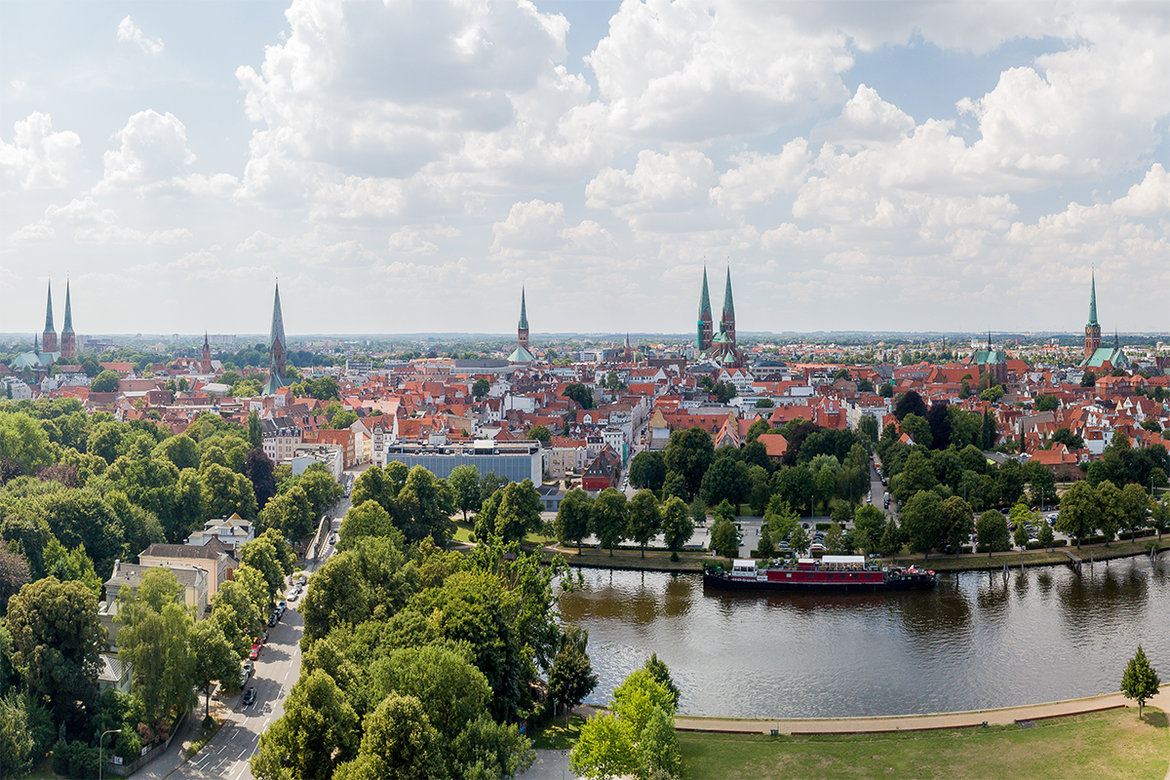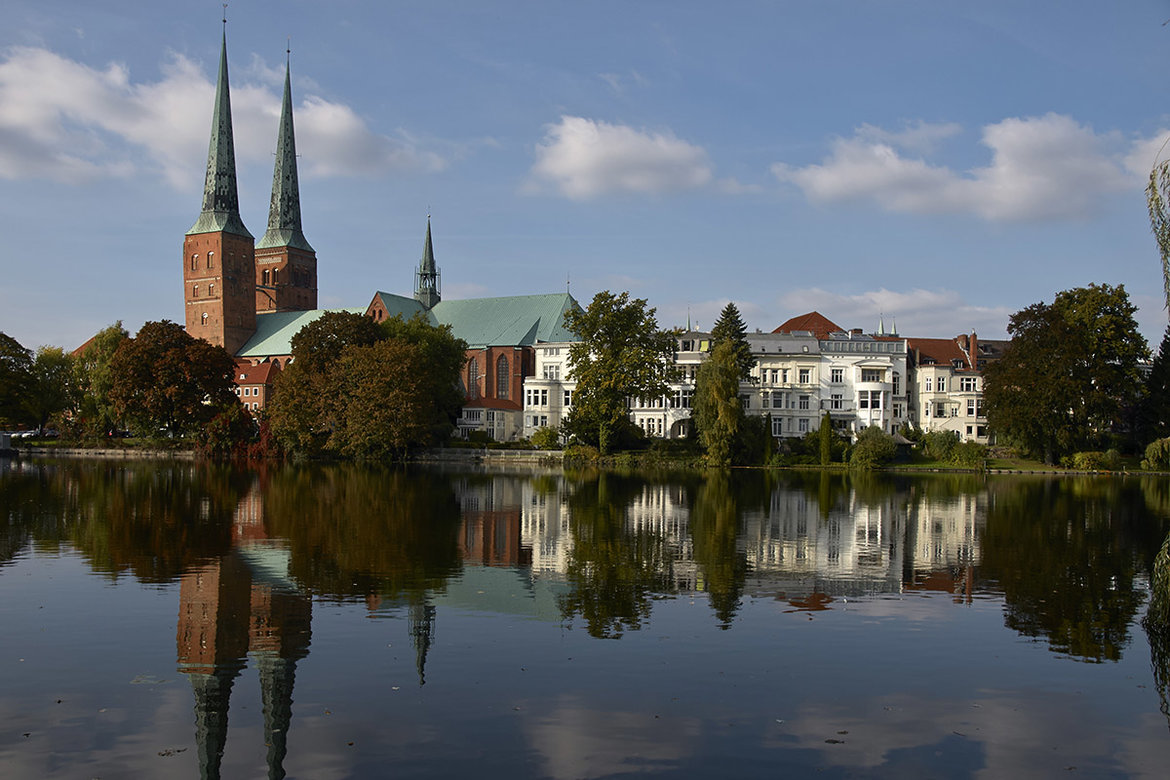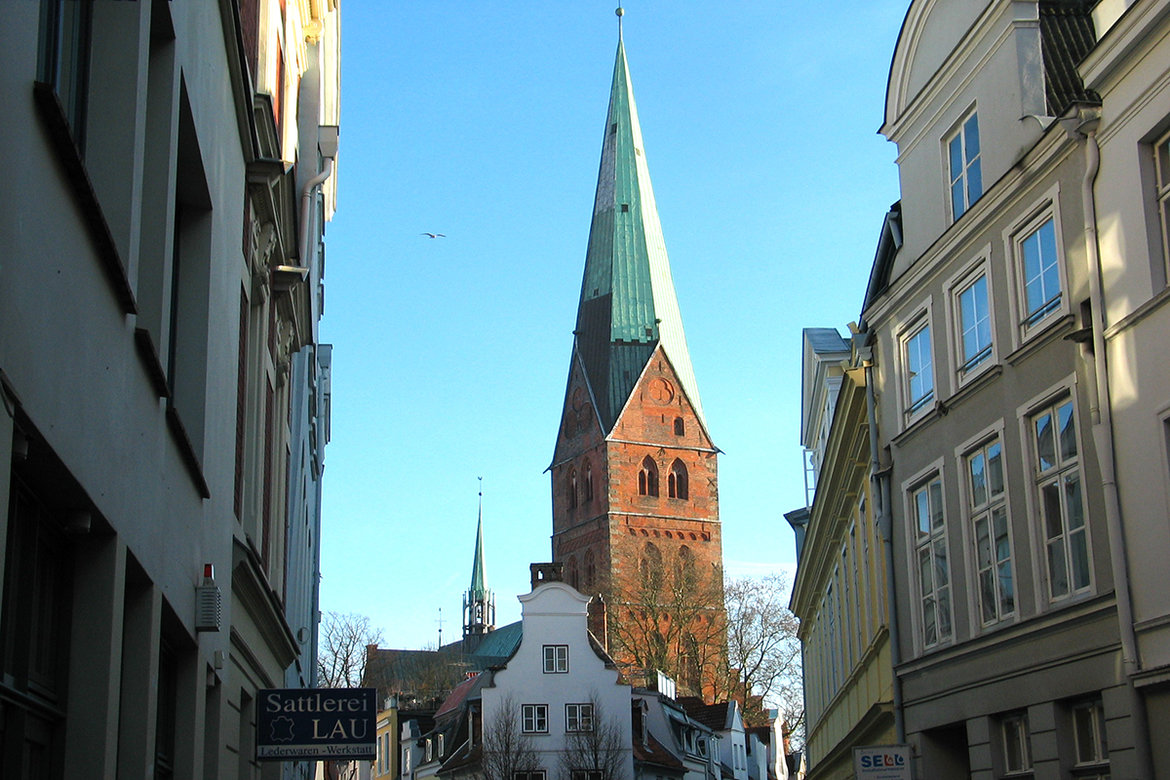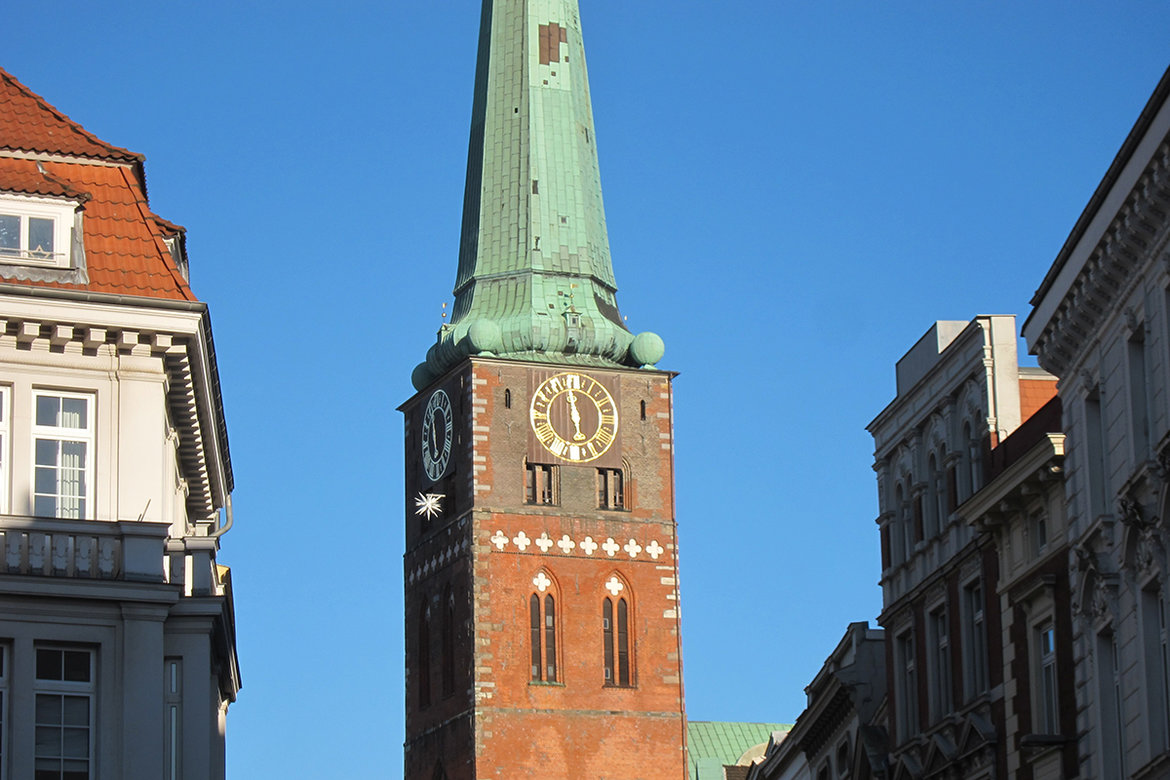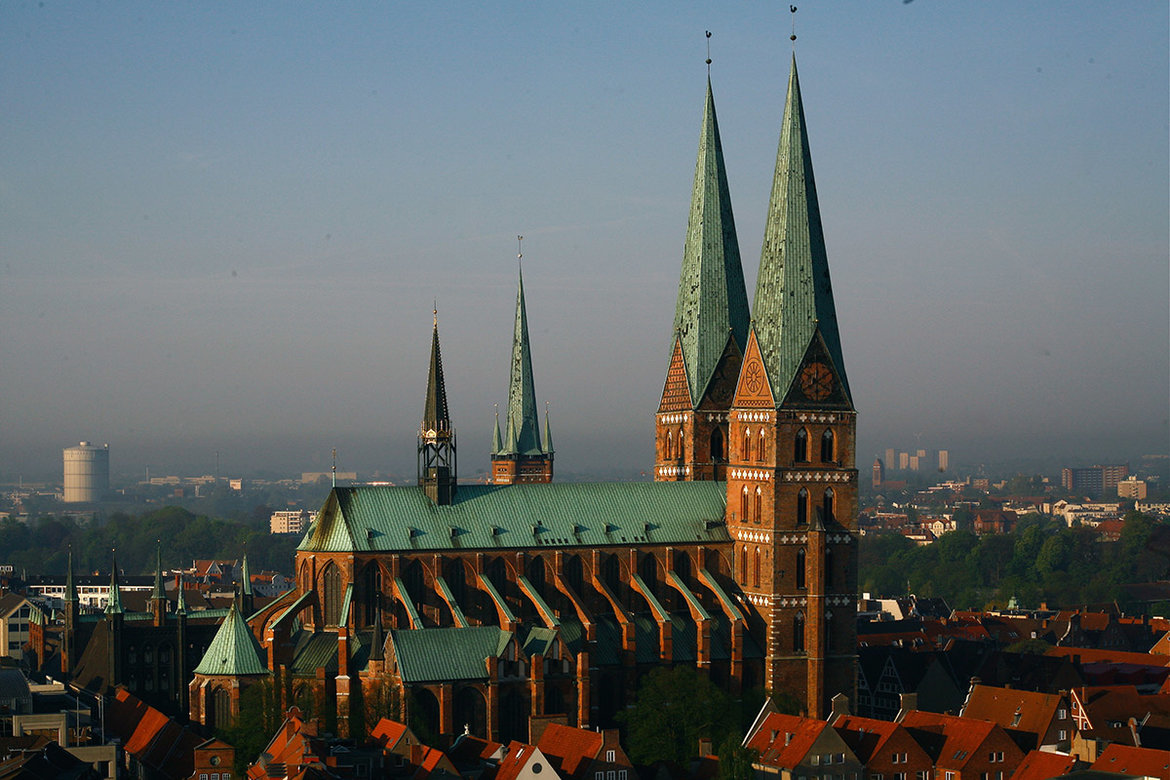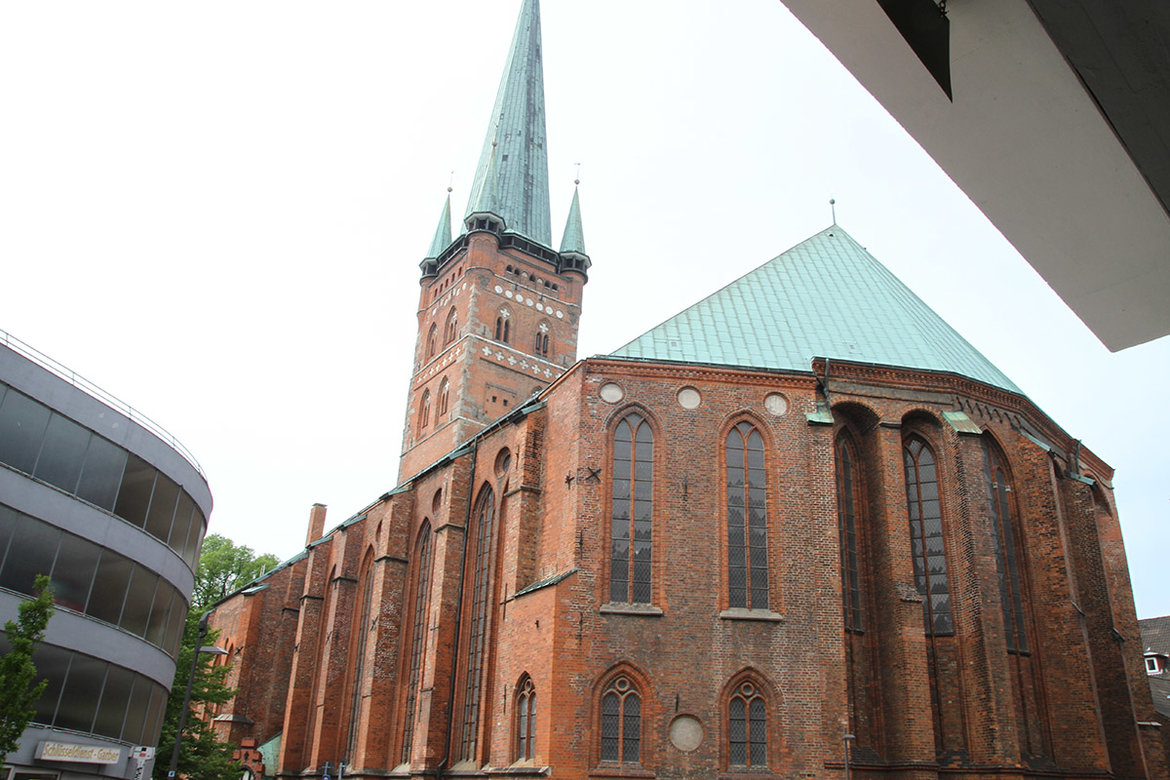DIE SILHOUETTE VON LÜBECK
Damit die erde hafte am himmel, schlugen die menschen
kirchtürme in ihn
Sieben kupferne nägel, nicht aufzuwiegen
mit gold
(Reiner Kunze, auf eigene hoffnung. gedichte, Frankfurt am Main 1981, 44)
In Portrait - the Seven Towers
Loved, admired and marvelled: Lübeck's seven towers
They shape the city skyline more than anything else: Lübeck's seven towers. They were built brick by brick by many generations. Today they are loved, admired and marvelled at. The five inner-city churches on the Old Town Island are witnesses to living history.
The Cathedral is the old bishop's church and still the bishop's place of preaching. Many people gather on Sundays for festive services with church music and communion. St. Mary's was and still is the council church. With its unique architecture, it is considered a model of Brick Gothic in the Baltic region and is the first place to go for many tourists. St. Peter's was once built as a church for fishermen and today functions as a cultural and university church without its own parish. St. Jacob's as an old seafarer's church today also welcomes pilgrims from all over the world. It is home to the Pamir memorial. The church is also famous for its historic organs. St. Gile's, located in the centre of the old craftsmen's quarter, is the smallest of the five inner-city churches and is closely linked to the Aegidien quarter and its inhabitants. In 1529, the "Singekrieg" (Singing War) began in this church and in St. Jacob's, when courageous Lübeckers raised their voices and sang Lutheran songs. They fought for the right to read Lutheran scriptures. Their protest triggered a peaceful revolution: The Reformation made its way into the Hanseatic city. At Pentecost 1531, the city council proclaimed the "Christian Order of the Imperial City of Lübeck" - the Protestant faith was now allowed to be lived openly.
The Cathedral
It stands majestically: Lübeck Cathedral. When you enter the imposing church hall, you can literally feel the centuries-old history that seem to float in the air. This is exactly where church life in Lübeck began. In 1160, Henry the Lion decided to move the bishop's seat from Oldenburg to Lübeck and in 1173 the foundation stone of the Cathedral was laid. With ist episcopal seat, the Hanseatic city had a radiant power that reached far beyond the city's borders. Even after the bishops moved their seat to Eutin in 1309, the Cathedral remained an important spiritual centre of the town as an episcopal church alongside the parish churches. Today, bishops of the Northern Church preach here at regular intervals. The Cathedral's twin towers, like the tower of St. Peter's and the twin towers of St. Mary's, fell victim to British bombs on Palm Sunday night 1942 - they burned and collapsed the next day.
St. Gile's
St. Gile's (St. Aegidien) was once a "branch" of Lübeck Cathedral - but it soon became "independent". The present three-nave church was built in the first half of the 14th century, and its choir was built in the middle of the 15th century. The quarter around the church is the district of the craftsmen and agrarian citizens - they were instrumental in helping the Hanseatic city rise as Queen of the Hanseatic League in the Middle Ages. Today, the smallest of Old Townt Churches amazes with its opulent and partly playful inventory, so that it is also very popular for wedding ceremonies. It is also the venue for high-level readings and lectures on art, literature and theology.
St. Jacob's
St. Jacob's - the church of the seafarers is today also appreciated for its organ music and as a place of pilgrimage. It was built around 1300 to replace the previous church, which was destroyed by a town fire in 1276, and consecrated in 1334. In 1658, the church received its characteristic pointed spire with the four spheres at the base of the helmet. St. Jacob's Church is located on the Koberg in the former skippers' quarter. The tower clock on all four sides of the tower has always had only one hand. The church houses the Pamir memorial. The only surviving wreck of the lifeboat of the four-masted barque Pamir, which sank in 1957, commemorates the accident in which 80 of 86 crew members lost their lives. St. Jacob's is the national memorial for civilian maritime shipping.
St. Mary's
St. Mary's Church has always been the City Council Church - due to its proximity to the city hall. Construction began in 1251 (after the previous church fell victim to a fire) and a Brick Gothic monument was created. The bronze sculpture "The Sitting Devil" in front of the church is a popular photo motif. A legend tells that he was once lied to by the builders and helped with the construction in the belief that an inn was being built here. But when it dawned on him that it was going to be a place of worship, he wanted to destroy the church with a huge stone. The people of Lübeck begged him to spare the church. They promised him to build a new inn: the Ratskeller. And so the devil threw the stone in front of the church, on which he still sits and watches today... On Palm Sunday night 1942, bombs also hit St. Mary's twin towers, their helmets collapsing. Parts of the vault and bells also fell down.
St. Peter's
The beginnings of St. Peter's Church date back to the 13th century. St. Peter's was rebuilt and extended several times, between 1450 and 1519 the present five-nave church in ist unique form was built. On Palm Sunday night 1942, British planes bombed Lübeck's Old Town and the heavy copper roof of the spire collapsed onto the vaults (which fortunately withstood). Restoration work began in 1961 and was completed in 1987. Today, St. Peter's functions as a church of culture and science. It does not have its own parish, but many special concerts, readings, exhibitions and series such as the "Petrivisionen" take place, attracting art lovers from near and far.



